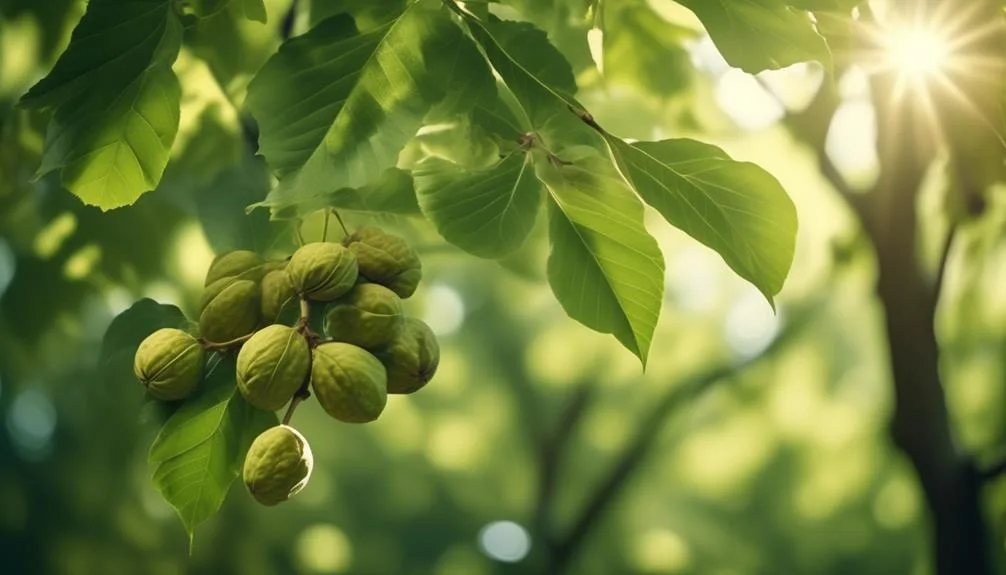Did you know there are over 20 types of walnut trees around the world?
If you're interested in seeing these impressive trees in their natural environment, you're in luck. Whether you love nature, gathering wild food, or simply enjoying the outdoors, finding wild walnut trees can be a fun adventure.
You can find them in dense forests and along peaceful riverbanks. If you've ever wondered where to find these hidden treasures, keep reading.
Key Takeaways
- Wild walnut trees are commonly found in wooded areas, forests, riverbanks, and streams.
- They prefer to grow in areas with good drainage and near moist soil, such as along riverbanks.
- The distinctive characteristics of wild walnut trees include unique bark patterns, pinnate leaves, and round, green fruits that mature into hard-shelled nuts.
- These trees provide important wildlife and environmental benefits, such as stabilizing riverbanks, preventing erosion, and serving as a food source for wildlife.
Wooded Areas and Forests
When exploring wooded areas and forests, it's essential to stay alert and mindful of the diverse flora and fauna that thrive in these natural environments. Woodland foraging can be a rewarding experience, but it's important to have a good understanding of tree identification to ensure your safety and the sustainability of the ecosystem.
Look for trees with distinct bark patterns, leaf shapes, and fruit or nut structures. For example, walnut trees have unique pinnate leaves and produce round, green fruits that mature into hard-shelled nuts. Take note of the surroundings as well; walnut trees often grow near streams or moist soil.
Keep an eye out for signs of wildlife, such as nibbled nuts or tracks, as they can lead you to these valuable trees. Happy foraging!
Riverbanks and Streams
Exploring wooded areas and forests has likely provided you with a keen understanding of tree identification. Now, it's time to shift your focus to the rich ecosystems found along riverbanks and streams.
Riverbanks and streams aren't only beautiful and peaceful places but also potential hotspots for finding wild walnut trees. Here's what to look for:
- Nut Harvesting: Keep an eye out for fallen walnuts along the riverbanks. The presence of cracked nutshells or signs of wildlife feeding on walnuts can indicate the proximity of wild walnut trees.
- Erosion Control: Wild walnut trees play a vital role in stabilizing riverbanks and preventing erosion. Their extensive root systems help anchor the soil, making them a crucial part of the riverine ecosystem.
Exploring these areas can be a rewarding experience, offering the chance to discover and harvest delicious wild walnuts while appreciating their contribution to erosion control.
Rural Farmlands and Orchards
In your exploration of rural farmlands and orchards, you'll discover a diverse landscape that offers a rich array of agricultural treasures.
When searching for wild walnut trees, keep an eye out for large, broad-leaved trees with rough, furrowed bark. Walnuts typically grow in well-drained soils, so look for them in areas with good drainage.
As you wander through these rural areas, take note of the different types of nut trees, such as hickory and pecan trees, which often grow alongside walnut trees.
Harvesting nuts can be a rewarding experience, but it's essential to correctly identify the trees and know when the nuts are ready for picking. Take the time to learn about the various nut-bearing trees and their distinct characteristics to make the most of your foraging adventures.
Hiking Trails and Nature Reserves
As you venture into the realm of hiking trails and nature reserves, you'll encounter an environment teeming with natural wonders, providing a seamless transition from the agricultural treasures of rural farmlands and orchards.
The following are some of the experiences you can look forward to on these trails:
- Wildlife Spotting: Keep an eye out for deer, squirrels, various bird species, and maybe even a fox or two.
- Tree Identification: Learn to distinguish between different types of trees, including the majestic walnut trees, as well as oak, hickory, and maple.
- Scenic Vistas: Take in breathtaking views of rolling hills, meandering streams, and lush forests.
- Nature Interpretation Centers: Visit centers along the trails to learn about the flora, fauna, and geological features of the area.
- Educational Guided Tours: Join guided tours led by naturalists to gain deeper insights into the ecosystem and wildlife.
Public Parks and Gardens
Amidst the urban landscape, public parks and gardens offer a serene escape into nature's embrace, inviting you to explore vibrant floral displays and tranquil green spaces. In these urban green spaces, you can engage in urban foraging, discovering hidden gems amidst city landscapes. Many public parks also feature community gardening initiatives, providing opportunities to get involved in cultivating and harvesting fresh produce. Here's a glimpse of what you can expect:
| Park/Garden Name | Location | Features |
|---|---|---|
| Central Park | New York City | Lush lawns, iconic landmarks |
| Butchart Gardens | Victoria | Stunning floral displays |
| Millennium Park | Chicago | Interactive art, serene gardens |
| Kew Gardens | London | Diverse plant collections |
| Shinjuku Gyoen | Tokyo | Japanese landscapes, cherry blossoms |
These public spaces not only provide a retreat from the hustle and bustle but also foster a sense of community and appreciation for nature's beauty.
Conclusion
So, grab your basket and get ready to explore the great outdoors in search of these tasty treasures!
Whether you're foraging, hiking, or simply enjoying nature, wild walnut trees can be found in wooded areas, riverbanks, and rural farmlands.
So, why not take a stroll and discover the hidden gems nature has to offer?

